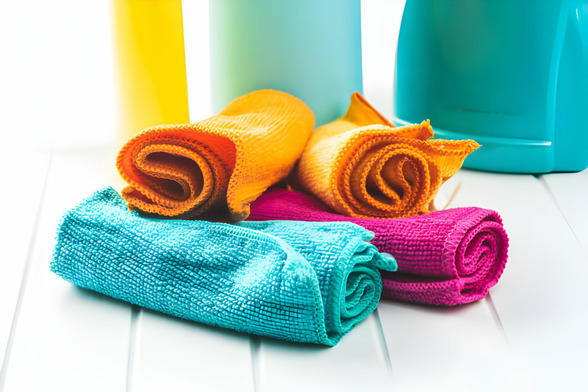
Microfiber is a synthetic material made of ultra-fine fibers that has revolutionized the way we approach household chores in the cleaning industry. It has changed the game in terms of cleanliness, and in this in-depth guide, we will delve into the wonders of microfiber, learning about its special qualities and how it has evolved into a necessary tool for effective and efficient cleaning.
Here is our post on 10 Benefits of Using Microfiber Mops and Cloths for Cleaning
Understanding Microfiber
Composition:
Microfiber is made up of incredibly fine synthetic fibers, usually composed of polyester and polyamide. These fibers are much smaller than a human hair, contributing to the material’s exceptional cleaning capabilities.
Microscopic Structure:
Under a microscope, microfiber looks like a myriad of tiny hooks and loops. This unique structure enables it to capture and hold onto dirt, dust, and bacteria with remarkable efficiency.
Absorbency:
Despite its small size, microfiber is highly absorbent. The spaces between the fibers create capillary action, allowing the material to absorb and retain a significant amount of liquid, making it ideal for cleaning up spills and messes.
Durability:
Microfiber is renowned for its durability. The fine fibers are tightly woven or knit, creating a sturdy fabric that can withstand frequent use and washing without losing its effectiveness.
Versatility:
Microfiber is a versatile cleaning tool that can be used for a wide range of surfaces. From countertops to glass, and even delicate surfaces like electronics or eyeglasses, microfiber adapts to various cleaning needs.
Benefits of Microfiber Cleaning
1. Efficient Dusting:
The static charge generated by microfiber when rubbed against a surface attracts and traps dust particles. This makes microfiber cloths and dusters highly effective for dusting surfaces without simply redistributing the particles.
2. Superior Cleaning Power:
The microscopic structure of microfiber allows it to reach into crevices and lift away dirt and grime that traditional cleaning materials might miss. This superior cleaning power results in a more thorough and hygienic cleaning experience.
3. Reduced Need for Chemicals:
Due to its effective cleaning properties, microfiber often requires less or no cleaning chemicals. Water alone, when used with microfiber, can be sufficient for many cleaning tasks, contributing to a more eco-friendly and budget-conscious cleaning routine.
4. Lint-Free Shine:
Unlike cotton or paper towels, microfiber leaves surfaces lint-free and streak-free. This makes it an ideal choice for cleaning glass, mirrors, and stainless steel, providing a shiny and polished finish.
5. Hypoallergenic Properties:
Microfiber is hypoallergenic, making it an excellent choice for individuals with allergies or sensitivities. Its fine fibers capture and hold onto allergens, preventing them from becoming airborne during the cleaning process.
See also our post on The Psychology of Clutter: How a Clean Home Affects Your Well-Being
Applications of Microfiber Technology
Household Cleaning:
Microfiber cloths and mops have become staples in households for general cleaning. Their ability to efficiently remove dirt and bacteria without the need for excessive chemicals makes them a go-to tool for daily chores.
Automotive Detailing:
Microfiber is widely used in the automotive industry for detailing cars. Its gentle yet effective cleaning properties are suitable for surfaces like glass, interiors, and exteriors, leaving vehicles spotless and polished.
Commercial Cleaning:
In the commercial cleaning sector, microfiber has gained popularity for its efficiency and cost-effectiveness. From office buildings to healthcare facilities, microfiber is used to maintain clean and sanitized environments.
Electronics Cleaning:
The delicate nature of microfiber makes it perfect for cleaning electronics. Microfiber cloths can safely remove fingerprints, smudges, and dust from screens without causing scratches or damage.
Janitorial Services:
Janitorial services in schools, offices, and public spaces benefit from the versatility and durability of microfiber. Mops, towels, and cloths made from microfiber simplify the cleaning process and contribute to a healthier environment.
Caring for Microfiber Products
Washing and Drying:
Microfiber is easy to care for, but it requires specific attention. Wash microfiber products separately from cotton fabrics to prevent lint transfer. Use a gentle detergent, avoid fabric softeners, and air-dry or use a low-heat setting in the dryer.
Avoiding Fabric Softeners:
Fabric softeners can leave a residue on microfiber, reducing its effectiveness. Opt for detergents specifically designed for microfiber or ones that are free from additives and softeners.
Separate Cleaning Tasks:
To maintain optimal cleaning performance, designate different microfiber cloths for various tasks. Use one cloth for dusting, another for surfaces, and a separate one for glass or electronics to prevent cross-contamination.
Inspecting for Damage:
Regularly inspect your microfiber products for signs of wear and tear. If the fibers become frayed or damaged, it’s time to replace the item to ensure continued efficiency.
Storage Tips:
Store microfiber products in a clean and dry environment. Avoid storing them in areas where they can accumulate dust or be exposed to contaminants, ensuring they are ready for use when needed.
Choosing the Right Microfiber Products
Density and Thickness:
When selecting microfiber cloths, consider their density and thickness. Higher-density cloths with finer fibers often provide superior cleaning performance.
Color Coding:
For different cleaning tasks, consider color-coding your microfiber cloths. This helps prevent cross-contamination and ensures that each cloth is used for its designated purpose.
Purpose-Specific Products:
Microfiber comes in various forms, including cloths, towels, mops, and dusters. Choose products designed for specific purposes to maximize their effectiveness in various cleaning scenarios.
Quality Brands:
Invest in microfiber products from reputable brands. Quality matters when it comes to durability and cleaning performance. Trusted brands often use advanced manufacturing techniques to produce high-quality microfiber.
Eco-Friendly Options:
For environmentally conscious consumers, there are eco-friendly microfiber options available. These products are often made from recycled materials or produced using sustainable practices, providing an eco-conscious cleaning solution.
See also our post on The Role of Technology in Modern Commercial Cleaning
Conclusion
Microfiber is a remarkable material that has the power to completely change the way we clean. Its distinct composition and wide range of uses have made it an essential tool in today’s cleaning industry. With the right knowledge of its characteristics, advantages, and maintenance, you can fully utilize microfiber to make your home or office more hygienic, productive, and ecologically friendly. As we continue to welcome breakthroughs in cleaning technology, microfiber is a prime example of how a tiny but significant advancement can have a profound effect on our daily lives.







